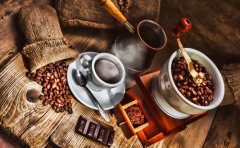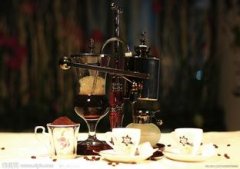The simplest roasting process of coffee beans talk about the roasting process.
The company's own brand coffee beans [Yikalama] (beans originally from Brazil, Nanshan roasting) will be fresh out of the pot soon. Today, let's simply popularize the baking process of coffee beans, but this is only the simplest baking process! The bean baking process of our company's [Yikalama] automatic coffee machine is much more complicated than this. If there are too many processes, I won't be wordy here any more. Let's move on.
Then take this opportunity to talk a little bit about the baking process.
These are raw beans:
Have sent the knowledge about coffee flavor wheel, if you want to review it, you can see it by replying to "flavor wheel".
So, we know that the flavor spectrum of coffee is divided into smell spectrum and taste spectrum, that is, the aroma and taste of coffee.
The baking process is to make raw bean sugars, proteins, organic acids, fenugreek base, fat in a period of baking to complete caramelization, Mena reaction, degradation and polymerization to create aromatic compounds.
The process of baking is the process of heat control, which requires accurate temperature control and data recording.)
The roasting of coffee beans is divided into five stages:
One: dehydration stage
In general, the water content of raw beans is about 10%-12%, which is the most suitable for baking, but it will increase or decrease with the humidity of the environment. After the raw beans entered the pot, the first stage of endothermic phenomenon began, the furnace temperature dropped sharply, and most of the moisture of raw beans was removed at this stage, in preparation for caramelization and Mena reaction. The gradual drying of water will trigger a series of chemical reactions of bean aromatics. At this stage, too much or too little firepower will cause dehydration too fast or too slow, which is not conducive to chemical reaction.
Second, the stage of igniting fire.
In the stage of producing heat impulse, the bean color changes from green to yellow, dehydration is completed, and the beans are no longer hard. After softening slightly, it begins to increase the firepower and obtain the thermal impulse to brew the best thermal environment for the next stage of caramelization and Mena reaction.
Third: degradation and polymerization of aromatic compounds (first explosion)
In the previous stage, a thermal impulse was created to quickly produce the temperature environment required for caramelization to react with Mena, between 170oC and 205oC. (caramel melting point is 186 °C)
At this point, the water in the coffee cell continues to evaporate, causing a chemical reaction, the sugar in the cell is caramelized and the amino acids Mena with carbohydrates. At this time, we must pay full attention to the change of furnace temperature and control the fire in time. At this time, the acidic components have not been completely degraded, and those who like sour taste will be baked before the second explosion (fine-tuning stage), for example, we
Four: cool down the beans
No matter what kind of baking degree, the moment out of the oven is still in the state of baking, and if the cooling is not good, the baking degree is likely to be upgraded or even scrapped.
Important Notice :
前街咖啡 FrontStreet Coffee has moved to new addredd:
FrontStreet Coffee Address: 315,Donghua East Road,GuangZhou
Tel:020 38364473
- Prev

Iced coffee recipes are more than just ice cubes in coffee.
Iced coffee recipe I like to drink coffee, but I dare not drink iced coffee sold outside, because good iced coffee is more than just ice cubes in the coffee. A friend forwarded an article about iced coffee, which made me want to try it sometime. Especially after buying the Dilange coffee machine, I am finally confident that I can make a good latte instead of just drinking it.
- Next

How to brew professional coffee with a household Italian coffee machine
Step 1: spoon the coffee powder into the coffee filter, use a visual observation that the coffee powder exceeds the level of the lid, and then use a flat knife or spoon to cut off the excess coffee powder. Step 2: flat knock coffee filter cover, which is why better Italian coffee machines use heavier metal to make coffee filter cover, because if it is made of other materials, it may not be able to stand too many times.
Related
- Beginners will see the "Coffee pull flower" guide!
- What is the difference between ice blog purified milk and ordinary milk coffee?
- Why is the Philippines the largest producer of crops in Liberia?
- For coffee extraction, should the fine powder be retained?
- How does extracted espresso fill pressed powder? How much strength does it take to press the powder?
- How to make jasmine cold extract coffee? Is the jasmine + latte good?
- Will this little toy really make the coffee taste better? How does Lily Drip affect coffee extraction?
- Will the action of slapping the filter cup also affect coffee extraction?
- What's the difference between powder-to-water ratio and powder-to-liquid ratio?
- What is the Ethiopian local species? What does it have to do with Heirloom native species?

